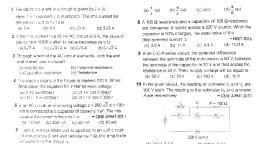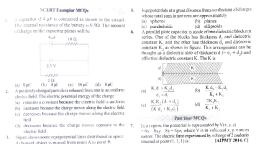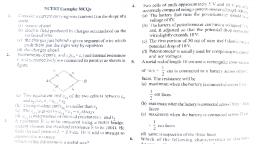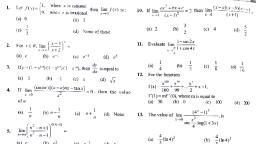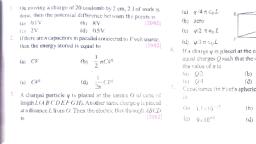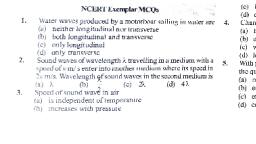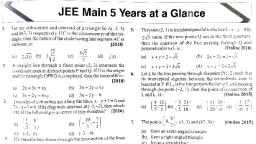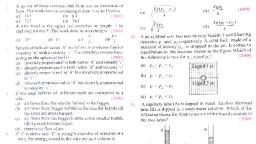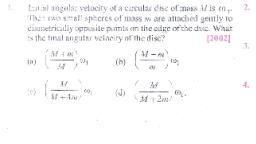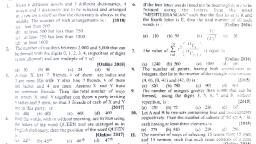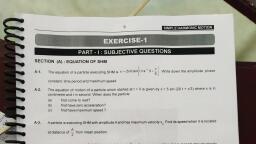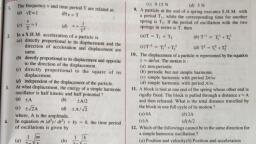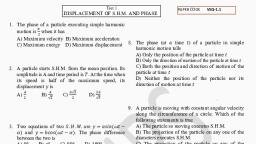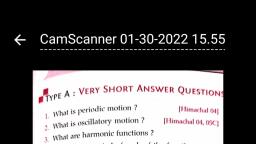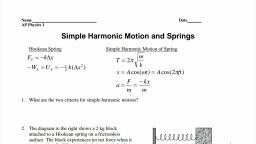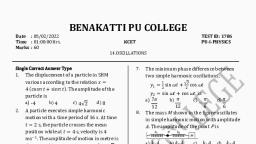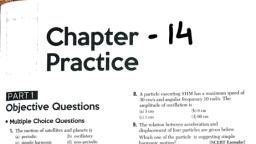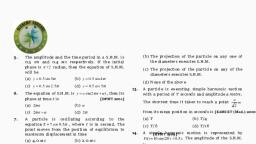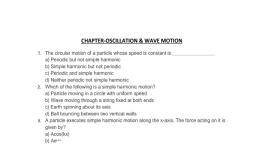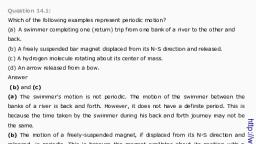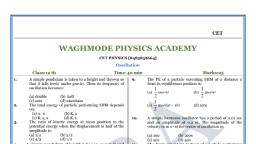Page 1 :
Figure shows the circular motion of a particle. The radiue of, the circle, the period, sense of revolution and the initiol, , NCERTExemplar MCQs, The displacement ofa particle is represented by the equation, , 1., , y=3cos, , The motion, , position are indicated on the figure. The simple harimoonic, motion ofthex-projection of the radius vector of the rotating, , oftheparticleis, , particle Pis, , (a) simple harmonic with period 27t/w, (6) simple harmonic with period To, C) periodic but not simple harmonic, The, of a particle is represented, y, sin3 ot. The motion is, , displacement, , by the equation, , (6) periodic but not simple harmonic, (c)simpleharmonic with period 27t/0, , (d) simple harmonic with period r/o, , T, , 30, , 9., , The relation between acceleration and displacement of four, , B, , The equation of motion ofa particle is x=a cos(a)). The, motion is, , (a) periodic but not oscillatory, , exempting simple harmonic motion?, (a) a+2x, (6) a, =+2x2, (c) a,=-2x2, (d) a -2x, Motion of an oscillating liquid column in a U-tube is, (a) periodic but not simple harmonic, , 30s, , (d) r()= Bcos, , particles are given below. Which, one of the particle is, , 4., , P=0), , Bsin 27TI, , (c) x() =Bsin+|, 2, , (a) non-periodic, , 3., , =, , (b) x()= Bcos 15, , (d) non-periodic, 2., , x(), , (a), , (6) periodic and oscillatory, , 10., , (b) non-periodic, , (c) oscillatory but not periodic, (d) neither periodic nor oscillatory, A particle executing SHM maximum specd of 30 cm/s anda, maximum acceleration of 60 cm/s2. The period ofoscillation is, , (c)simple harmonic and time period is independent ofthe, , 5., , density of the liquid, (d) simple harmonic and time period is directly proportional, to the density of the liquid, A particle is acted simultaneously by mutually, perpendicular, simple harmonic motion x =a cos ot and y =a sin ot. The, , (a), , (b), , sec, , (c), , 2r sec, , 11., , X=Acos (ot), , d) a straight line, The displacement ofa particle varies with time, according to, , X=displacement at timet, , frequency of oscillation, graphs shows correctly the, , Which one of the following, variation of 'a' with 't?., , the relation y = a sin of + b cos o., , AIPMT 2014, C], , (a) The motion is oscillatory but not SHM, (b) The motion is SHM with amplitude a + b, , (a) o, , (c)Themotion is SHM with amplitude a2 +b2, 7., , SeC, , The oscillation of a body on a smooth horizontal surfaceis, represented by the equation,, , where, , (c)acircle, , (d), , (d), , Past Past, Year MCQs, , trajectory of motion oftheparticle will be, (a) an elipse, (b) a parabola, 6., , t Sec, , (b), , T1, , The motion is SHM with amplitude ya+b2, , Four pendulums A, B, C and D are, , (c) O, , suspended from the same elastic G, support as shown in figure. A and Care, of the same length, while B is smaller, than A and D is larger than A. IfA is, given a transverse displacement,, , (a) Dwill vibrate with maximum amplitude, (b) Cwill vibrate with maximum amplitude, , (c) Bwill vibrate with maximum amplitude, (d) All the four will oscillate with equal amplitude, , 12., , Tt, , y=2(cm)sin, , +, , what, , (d), , T, , isthemaximum acceleration of, TAIMS, 2014, C, , the particle doing the S.H.M., T, , (a)cm/s2, , (b), , (c), , (d) cm/s2, , cm/s, , cm/s2
Page 2 :
13., , 14., , Resonance, , is an exampleof, , (a), , tuning fork, , (c), , free vibration, , AIIMS 2014, CI, , KE, , b)forced vibration, , (d) damped vibration, , (a), , Assertion: In simple harmonic motion, the velocityy is, , PE, , (b), , d, , KE, , maximum when the acceleration is minimum., , p, , Reason: Displacement and velocityof S.H.M.difier in phase, , PE, , AIIMS 2014, CI, , by, (a), , Assertion, , , KE, , (c), , is correct, reason is correct; reason is a, , (b), , d, , Assertion is correct, reason is correct;, correct explanation for assertion, , (c) Assertion, 15., , is correct,, , reason, , (d) Assertion is incorrect, reason, , reason, , is not, , a, , 20., , The displacement of a particle is given at timet, by:, , with an amplitude of, (a) the motion ofthe particle is SHM, , is correct., , Aparticle moves with simple harmonic motion in a straight, , B, , line. In first ts, after starting from rest it travels a distance a,, and in next ts it travels 2a, in same direction, then:, JEE Main 2014, C], , a) amplitude of motion, (b) timeperiod of oscillations is 8t, c)amplitude ofmotion is 4a, (d) time period of oscillations is 6t, , (c), , of T Tn/2, , At the corners of an equilateral triangle of side a (l metre),, , three point charges are placed (each of0.1 C). Ifthis system, is supplied energy at the rate ofl kw, then calculate the, time required to move one of the mid-point of the linejoining, , [BITSAT 2014, A, , the other two., , but oscillatory, the motion of the particle is not SHM,, ofT=r/o, with a time period, with a time period, the motion of the particle is oscillatory, , (b), , is 3a, , 16., , BITSAT 2015, C], , X= Asin(-20/) + B sin o Then,, , incorrect, , is, , (d), , PE, , correct explanation for assertion., , a, (d) the motion ofthe particle is periodic.to the scale, pan, a, from, falls, height h on, 21. A load of mass m, the, If, the, spring, in, figure., hung from the spring as shown, zero and the mass, is, scale, mass, pan, constant is k and, ofthe, to the pan, then the amplitude, m does not bounce relative, of vibration is [BITSAT 2015, S, (a) mg/d, , mg1+2hk), , (b), , k V, , mgmg 1+2hk, , (c, , B, (a), 17., , 50h, , (b), , 22., 60 h, , (d) 54h, , (c) 48h, , Aparticle is executing a simple harmonic motion. Its, , maximum, , Then its time period ofvibration will be:, , 27tp, , 18., , (d), , 57/6, T3, , (b), (d), , 2, , b) T/N2, , T, , kinetic, , d. Which one of the following represents these correctly?, schematic and not drawn to scale), , JEE Main 2015, C, , AIIMS 2016, A], , (d) 2T, motion in a straight, Aparticle moves with simple harmonic, it travels a distance, rest,, from, line. In first t s, after starting, , 24., , same, , direction then, , AIIMS 2016, A], , (a) amplitude ofnotion is 3a, (b) time period ofoscillations is 8t., (c) amplitude of motion is 4a., (d) time period of oscillations is 6t., with amplitude, particle performs simple harmonic mition, A. Its, , between its, simple pendulum, a graph is plotted, its displacement, energy(KE) and potential energy (PE) against, , graphs are, , mg, a, The period of oscillation of a mass M suspended from, another mass, spring of negligible mass is T. Ifalong with it, will now be, oscillation, of, M is also suspended, the period, , 2a in, a, and in next ts, it travels, , 2 7/3, Td6, , For a, , h, , mg, k, , (c) 2T, 23., , and, Twoparticles are executing S.H.M. ofsame amplitüdeeach, line, pass, path. They, trequency along the same straight, time their, other when going in opposite directions, each, the phase, is, What, displacement is halfof their amplitude., AIMS, 2015, A|, difference between them?, , (a), (c), 19., , [AIPMT 2015, A], , mg, , mg 1+2hk, , (a), , acceleration is a and maximum velocity is B., , b), , k, , d), , D, , mg, , speed is, , trebled at the instant that it is at, , 2A, , from equilibrium position., , The, , new, , a, , distance, , amplitude, , of the, , 3, , JEE Main 2016, A], , motion is:, 7A, , (a) Av3, , (b), , (c), , 4l, , (), , 3A
Page 3 :
A pendulum clock loses 12 sa dayifthe temperature 40°, and, is, , gains 4, , C. The, temperature at which the clock will show correct time, and, s a, , day if the temperature, , is 20", , (a), , (b), , (c), , (d), , the co-efficient of linear expansion ( a) ofthe metal of the, , pendulum shaft are respectively:, , (a), , 30°C; a = 1.85x 10/°C, , (6), , 55°C; a = 1.85 x 102/C, , |JEE Main 2016, S|, , 32., , (c) 25°C; a =1.85 x 10 SPC, (d), , 26., , The following figure depict a, circular motion. The radius of, , 60°C; a = 1.85 x 104/°C, , find, , The simple harmonic motion of the x-project1on of the, radiu, vector of the rotating particle P can be shown as, , (BITSAT 2016, S], , 0.5kg, , 3m/s, , BITSAT 2017, A, (a), , x()= a cos, , +, , b) Scm,, , 10, , (c) 4cm,, 27., , 33., , (d) 4cm, S, , A, , point particle of mass 0.1 kg is executing S.HM, of, amplitude of 0.1 m. When the particle passes through the, mean position,, its kinetic energy is 8 10-5 Joule. Obtain, the equation of motion of this, particle if this initial phase of, oscillation is 45°., BITSAT 2016, A], x, , y=0.1sin 41+, 28., , 34.,, , A, , pendulum is hung, , from the roof of a, , (, , an, , position, the magnitude of its velocity is equal to that, of its acceleration. Then its time, period in seconds is, [NEET 2017,A|, , 30., , A, , 2TT, , spring, , (), , (d), , of force constant k is cut into, , Aparticle is, , b)081, , c)0.729, , 35., , (b), , lengths, , AlIMS 2017, A|, , A particle of mass is, , executing oscillations about the orign, on the x-axis. Its potential energy is V(x)=k x where k is, its time period T is, (a), , proportional to, , (c), , independent a, , 36., , JEEMain 2017,C1, , Va, , (b), , proportional to a, , (d), , None of these, , is doubled, its total energy becomes four times., , Reason: The total energy is directly proportional tothe, square of the amplitude of vibration of the harmoni, , AIIMS 2018, C, , Oscillator., (), , Assertion, , (b), , explanation tor assertion., correct, Assertion is correet, reasom is correct; reason, , period T. At timet=0, it is at its position of equilibrium. The, , like:, , [ANMS 2018, S|, , Assertion : lfthe amplitude ofa simple harmonic oseillator, , (d, , of theparticle will look, , 27t, , d)2, , 2Tt, , of ratio, , 06, executing simple harmonic motion with a tine, , kinetic energy-time graph, , T, , AIIMS 2018. A], , a positive constant. If the amplitude of oscillation is a, then, , T, , 1:2:3. They are connected in series, and the new force, constant is k. Then they are connected in, parallel and force, constant is k". Then k:" is, NEET 2017,A, (a) 1:9, (b) 1:11 (c) 1:14 (d) 1:6, The amplitude of a damped oscillator decreases to 0.9 times, its original magnitude in 5s. In another 10s it will decrease to, times its original magnitude, where a equals, (a) 0.7, , 31., , )b)5, , 27T, , suftficiently high, , A, , d) y=02sin| +2t+, , mean, , 29., , r{1) =acos, , A, , amplitude of 3 cm. When the particle is at 2 cm from the, , 4T, , (d), , distancestarting from rest is, T, (a) T, Cos, , (b)y=0.2sin| t4t+, , A particle executes linear, simple harmonic motion with, , (a), , x(t) = a cos, , building and is moving freely to and fro like a simpe, harmonic oscillator. The acceleration of the bob of the, pendulum is 20 m/s* at a distance of 5 m from the mean, position. The time period of oscillation is [NEET 2018 A, (a) 27ts, b) Ts, C) 1s, (d) 2s, A particle performs SHM on x-axis with, amplitude and, time period T. The time taken by the particle to travel a, , 20, , ()y=0.1sin| +2t+, , (b), , kg 0000(c)x(t) asin, , (a) 5cm,1S, , Pt 0, , revolution, the initial position, and the sense of revolution, are indicated on the figure, , amplitude and time period of oscillation of combined, , mass., , T-4, , the circle, the period of, , Al kg mass is attached to a, spring of force constant, 600 N/m and rests on a smooth horizontal surface with other, end of the spring tied to wall as showm in figure. A second, mass of 0.5 kg slides along the sur face towards the first at, 3m/s. If the masses make a perfectly inelastic collision, then, , (c), (d), , is correct, reason is correct: reason is a, , correct explanation, , for assertion, , Assertion is correct, reason is incorrect, , Assertion is incorreet, reason is correct., , i8 notd
Page 4 :
37., , A silver atom in a solid oscillates in simple harmonic motion, in some direction with a frequency of 102/sec. What is the, force constant of the bonds connecting one atom with the, other? (Mole wt. ofsilver = 108 and Avagadro number, , =6.02 x105 gm mole ), (a) 6.4 N/m (b) 7.1 N/m (c), , [JEE Main 2018, S], 2.2 N/m (d) 5.5 N/m, , 38., , started simultaneously in same phase., that, After 50 oscillations of one, they get out of phase by t,, of, frequencies, difference, is half oscillation. The percentage, BITSAT 2018, A, of the two oscillators is nearest to, , Two oscillators, , (a), , 2%, , are, , (b) 1%, , (c)0.5%, , (d), , 0.25%

